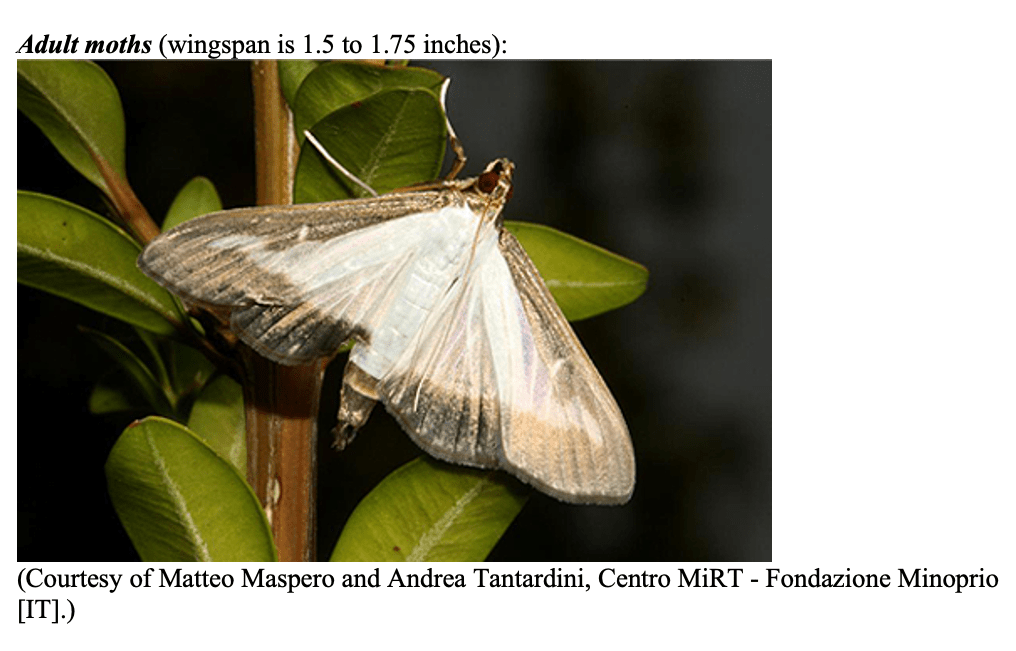Box Tree Moth a serious threat to plant health
Box Tree Moth (BTM) first appeared in New York State in 2021, likely carried on a storm from an infestation just across the border in Ontario, Canada. Infestations have been identified in Niagara and Orleans county in 2023; the impacted range may expand through natural movement.
The BTM is an invasive pest that can significantly damage—and potentially kill—boxwood plants if left unchecked.
In 2021, infested Canadian boxwood plants were shipped to seven states: Connecticut, Massachusetts, Michigan, New York, Ohio, South Carolina, and Tennessee.
Many of the potentially infested boxwoods were then moved to other states.
How Residents Can Help
The moths can produce several generations between June and October, so quick action is needed to prevent this damaging pest from becoming established here.
We’re asking boxwood buyers to follow three simple steps:
- Check any boxwood plants for signs of the box tree moth.
- If you find any signs of infestation, report it to your local USDA office or state department of agriculture.
- Allow agriculture officials to place a box tree moth trap on your property, if needed.
You can find how to do this on USDA’s box tree moth web page.
Where To Look
Look for young caterpillars hiding among the twigs and leaves.
The caterpillars are green and yellow. They have white, yellow, and black stripes and black spots.
The caterpillars eat the leaves and stems, leading to the plant’s death.
Signs of feeding include chewed, cut, or missing leaves, yellowing or brown leaves, white webbing, and green-black excrement on or around the plant.
The female moths lay their eggs on the underside of the leaves of boxwoods.
What’s at Stake
Boxwoods are important plants for Americans in many ways:
They are popular shrubs that are used all over the country.
- Boxwoods are an excellent choice for hedges and topiaries.
- Older boxwoods can hold great historical value, such as the 150-year-old boxwoods that were at the Carl Sandburg Home National Historic Site in North Carolina. Unfortunately, these plants needed to be destroyed because they had boxwood blight.
- Boxwoods are included in many States’ own historical gardens.
Boxwoods are also a valuable part of the U.S. nursery industry.
- The moth threatens the economic viability of America’s boxwood industry, as well as nurseries and other businesses that sell these plants wholesale and direct to consumers.
- In fact, boxwoods have an estimated $141 million economic impact in the United States, according to one industry estimate (AmericanHort).
Background on the Box Tree Moth
The box tree moth is native to East Asia.
It has become a serious invasive pest in Europe, where it continues to spread.
The caterpillars feed mostly on boxwood and heavy infestations can defoliate host plants.
Once the leaves are gone, larvae consume the stems and bark, leading to girdling and plant death.
Females lay eggs singly or in clusters of 5 to more than 20 eggs in a gelatinous mass on the underside of boxwood leaves.
Most females deposit more than 42 egg masses in their lifetime. They typically hatch within 4 to 6 days.
Pupation occurs on the host leaves in cocoons. If the boxwood host is defoliated, pupation may occur away from the host plant using leaves from the surrounding area.
Pupae typically first appear in April or May and are present continuously through the summer and into the fall, depending on the local climate and timing of generations.
Adults first emerge from the overwintering generation between April and July, depending on climate and temperature.
Subsequent generations are active between June and October. Adults typically live for two weeks after emergence.
Box tree moths are very active and can be good fliers.
In Europe, the moth can spread about 3 to 6 miles per year.
One analysis from Europe concluded that natural dispersal from continental Europe to the United Kingdom was possible, suggesting sustained adult flights of over 20 miles.
When people inadvertently move infested plants, invasive pests can spread much faster and farther.





